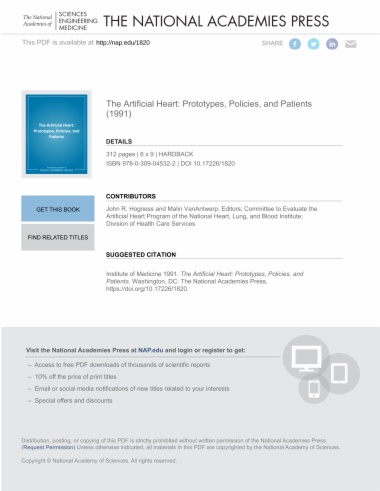A significant medical event is expected in 1992: the first human use of a fully implantable, long-term cardiac assist device. This timely volume reviews the artificial heart program—and in particular, the National Institutes of Health's major investment—raising important questions.
The volume includes:
- Consideration of the artificial heart versus heart transplantation and other approaches to treating end-stage heart disease, keeping in mind the different outcomes and costs of these treatments.
- A look at human issues, including the number of people who may require the artificial heart, patient quality of life, and other ethical and societal questions.
- Examination of how this technology's use can be targeted most appropriately.
- Attention to achieving access to this technology for all those who can benefit from it.
The committee also offers three mechanisms to aid in allocating research and development funds.
- Cover
- Front Matter
- Executive Summary
- 1. The Artificial Heart Program: Current Status and History
- 2. Total Artificial Hearts: Technological Potential and Research and Development Costs
- 3. Decisions for Future Research and Development
- 4. Clinical Effectiveness and Need for Long-Term Circulatory Support
- 5. Quality of Life and Mechanical Circulatory Support Systems
- 6. Cost-Effectiveness Analysis
- 7. The Appropriate Use of Technology
- 8. Ethical and Societal Issues
- 9. Roles of Government and Industry in Medical Technology Research, Development and Use
- 10. Conclusions and Recommendations
- Appendix A: History and Methods of This Evaluation
- Appendix B: A Chronology of the National Heart, Lung, and Blood Institute Artificial Heart Program and Related Events
- Appendix C: Technological Opportunities and Barriers in the Development of Mechanical Circulatory Support Systems
- Appendix D: Epidemiology of End-Stage Heart Disease
- Appendix E: Assessing the Cost-Effectiveness of the Development and Use of the Total Artificial Heart
- Glossary
- Index

